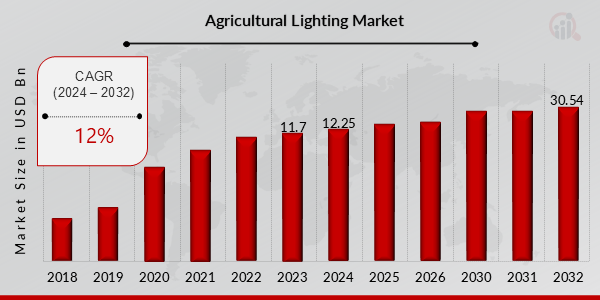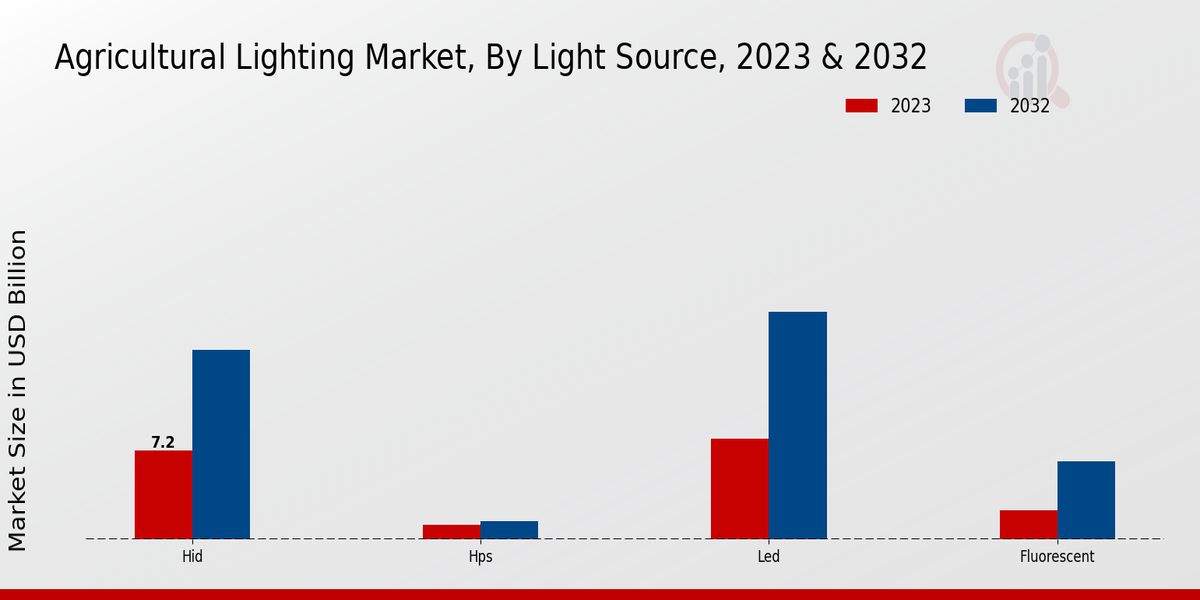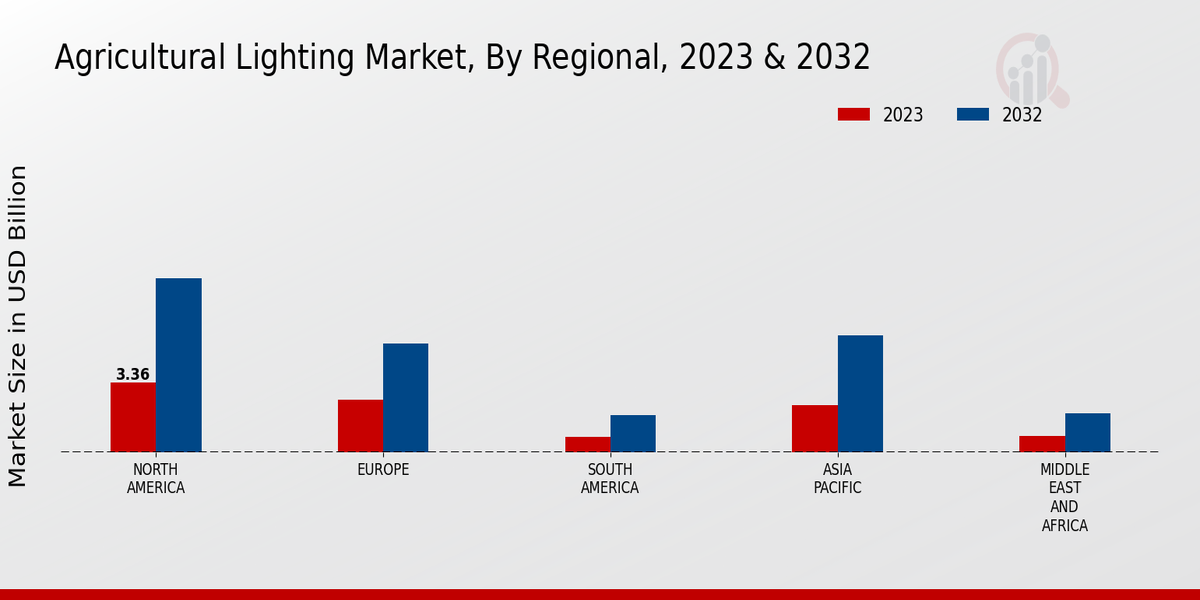Global Agricultural Lighting Market Overview:
Agricultural Lighting Market Size was estimated at 11.7 (USD Billion) in 2023. The Agricultural Lighting Market Industry is expected to grow from 12.25 (USD Billion) in 2024 to 30.54 (USD Billion) by 2032. The Agricultural Lighting Market CAGR (growth rate) is expected to be around 12% during the forecast period (2024 - 2032).
Key Agricultural Lighting Market Trends Highlighted
The Agricultural Lighting Market is fueled by surging demand for increased crop yield, advancements in LED technology, and government initiatives promoting sustainable farming practices. As urban populations rise, the need for efficient food production intensifies, driving the adoption of controlled environment agriculture (CEA). LED lighting systems optimize plant growth by providing tailored light spectrums, enabling year-round cultivation and enhancing crop quality. Additionally, the integration of IoT and sensors allows for precise lighting control, maximizing crop yields and reducing energy consumption.

Source: Primary Research, Secondary Research, MRFR Database and Analyst Review
Agricultural Lighting Market Drivers
Rising Demand for Sustainable and Efficient Lighting Solutions
The increasing demand for energy-efficient and sustainable lighting solutions is a significant market driver in the Agricultural Lighting Market Industry. Agricultural operations are energy-intensive, and lighting plays a crucial role in various indoor and outdoor applications. As the industry focuses on reducing its environmental impact and optimizing resource utilization, the adoption of LED and other energy-efficient lighting technologies is rapidly increasing.
LED lights offer several advantages over traditional lighting sources, including reduced energy consumption, longer lifespans, and better light quality. The integration of sensors, controls, and automation systems further enhances the efficiency and flexibility of lighting solutions, enabling farmers to optimize light levels and maximize energy savings. As a result, the growing demand for sustainable and efficient lighting solutions is driving the growth of the Agricultural Lighting Market Industry.
Government Initiatives and Regulations
Government initiatives and regulations aimed at promoting sustainable agriculture practices and energy efficiency are driving the growth of the Agricultural Lighting Market Industry. Governments around the world are recognizing the importance of agriculture and are implementing policies and programs to support farmers in adopting innovative technologies. These initiatives include financial incentives, tax breaks, and technical assistance to encourage the adoption of energy-efficient lighting solutions.
Additionally, regulations aimed at reducing energy consumption and promoting sustainable practices are creating a favorable environment for the growth of the agricultural lighting market. Governments are setting minimum energy efficiency standards for lighting products, which is supporting the adoption of advanced lighting technologies.
Advancements in Lighting Technologies
Advancements in lighting technologies are revolutionizing the Agricultural Lighting Market Industry. The development of high-efficiency LED lighting fixtures, sensors, and control systems is enhancing the functionality and performance of agricultural lighting solutions. LED lights offer superior light quality, enabling farmers to optimize light levels for specific plant growth stages and improve crop yields.
The integration of sensors and control systems allows for precise light management, enabling farmers to adjust light intensity, duration, and spectrum to meet the specific needs of their crops. These advancements are creating new opportunities for lighting manufacturers and solution providers to develop innovative products and services tailored to the unique requirements of the agricultural sector.
Agricultural Lighting Market Segment Insights:
Agricultural Lighting Market Light Source Insights
The Agricultural Lighting Market segmentation by Light Source comprises LED, HPS, HID, and Fluorescent. The LED segment held the largest market share in 2023 and is projected to maintain its dominance throughout the forecast period. LED grow lights offer several advantages over traditional lighting sources, including higher energy efficiency, longer lifespan, and the ability to customize the light spectrum to meet the specific needs of different plant species. The increasing adoption of LED lighting in commercial greenhouses and indoor farming facilities is driving the growth of this segment.
In 2023, the HPS segment accounted for a significant portion of the Agricultural Lighting Market revenue. HPS lights are widely used in horticulture due to their high light output and affordability. However, the growing popularity of LED lights is expected to gradually erode the market share of HPS lights in the coming years. HID lights, including metal halide and high-pressure sodium lamps, are another important segment in the Agricultural Lighting Market. HID lights offer high light intensity and relatively low operating costs, making them a viable option for large-scale commercial growers. However, HID lights consume more energy compared to LED lights and have a shorter lifespan.
Fluorescent lights are commonly used for plant propagation and in indoor gardening applications. They provide a relatively low-cost and energy-efficient lighting solution. However, the low light output of fluorescent lights limits their use in large-scale commercial applications. The Agricultural Lighting Market is expected to witness significant growth over the forecast period, driven by the increasing adoption of controlled environment agriculture, the rising demand for high-quality and year-round produce, and government initiatives to promote sustainable agriculture practices.

Source: Primary Research, Secondary Research, MRFR Database and Analyst Review
Agricultural Lighting Market Wavelength Insights
The wavelength segment plays a crucial role in the Agricultural Lighting Market segmentation. Different wavelengths of light have varying effects on plant growth and development. The '300-500 nm (UV)' range of the spectrum is primarily used for disinfection and pest control, as UV light can damage DNA and inhibit microbial growth. The '500-700 nm (Visible Light)' range is essential for photosynthesis, as plants absorb light in this range for energy production. The '700-1000 nm (NIR)' range promotes cell elongation and root growth and can also enhance flowering and fruiting. Understanding the specific wavelength requirements of different plant species and growth stages is crucial for optimizing lighting strategies. The Agricultural Lighting Market revenue is expected to reach $11.24 billion by 2024, with the wavelength segment contributing significantly to this growth.
Agricultural Lighting Market Application Insights
The Agricultural Lighting Market segmentation by Application is broadly classified into Greenhouse Lighting, Vertical Farming Lighting, Poultry Lighting, and Horticulture Lighting. Greenhouse Lighting dominated the market in 2023, accounting for a revenue share of around 35%, owing to the increasing adoption of controlled environment agriculture practices. Vertical Farming Lighting is projected to witness significant growth during the forecast period, driven by the rising demand for locally produced, high-quality crops.
Poultry Lighting, on the other hand, is expected to hold a steady share of the market, as it plays a crucial role in optimizing poultry production and welfare. Horticulture Lighting is anticipated to contribute a substantial revenue share to the Agricultural Lighting Market by 2032, supported by the growing popularity of indoor gardening and urban farming initiatives.
Agricultural Lighting Market Control System Insights
The Control System segment of the Agricultural Lighting Market plays a crucial role in optimizing lighting conditions for agricultural operations. Manual Control systems allow farmers to manually adjust lighting parameters such as intensity and duration, providing flexibility and control over the lighting environment. Automated Control systems leverage sensors and algorithms to monitor and adjust lighting conditions autonomously based on factors such as plant growth stage and environmental conditions. This automation enhances efficiency and reduces labor costs.
Wireless Control systems offer remote access and control of lighting systems, enabling farmers to manage lighting from anywhere, improving convenience and productivity. In 2023, the Automated Control segment held a significant share of the Agricultural Lighting Market revenue, driven by the increasing adoption of smart farming technologies and the need for precise lighting control. The Wireless Control segment is also anticipated to witness substantial growth as it empowers farmers with remote management capabilities and enhances operational efficiency. The overall Control System segment is expected to contribute significantly to the market growth, as it enables farmers to optimize lighting conditions for improved crop yield, energy efficiency, and operational efficiency in agricultural environments.
Agricultural Lighting Market Product Type Insights
The Agricultural Lighting Market is segmented by product type into lamps, fixtures, and luminaires. Among these, the lamps segment held the largest market share in 2023 and is projected to continue its dominance throughout the forecast period. The growth of this segment can be attributed to the increasing adoption of LED lamps in agricultural applications due to their energy efficiency, long lifespan, and ability to provide optimal lighting conditions for plant growth. The fixtures segment is also expected to witness significant growth, owing to the rising demand for specialized lighting fixtures designed to meet the specific lighting requirements of different agricultural environments. The luminaires segment is expected to grow at a steady pace, driven by the growing adoption of smart lighting systems that offer remote monitoring and control capabilities, enabling farmers to optimize lighting conditions in real time.
Agricultural Lighting Market Regional Insights
The Agricultural Lighting Market is expected to flourish over the coming years, with regional markets playing a significant role in driving growth. North America, Europe, APAC, South America, and MEA are key regional segments that offer unique opportunities for market expansion. North America holds a dominant position in the Agricultural Lighting Market, accounting for a substantial revenue share. The region's advanced agricultural practices, coupled with rising investments in controlled environment agriculture, contribute to its market growth.
Europe follows closely, showcasing promising growth prospects due to government initiatives and increasing adoption of precision farming techniques. APAC presents a burgeoning market for Agricultural Lighting, driven by rapidly growing economies and a surge in demand for high-quality food production. China and India emerge as significant contributors to the regional market, owing to their vast agricultural sectors and government support for modernization. South America and MEA also exhibit growth potential, with increasing investments in agricultural infrastructure and a growing focus on sustainable farming practices.

Source: Primary Research, Secondary Research, MRFR Database and Analyst Review
Agricultural Lighting Market Key Players And Competitive Insights:
Major players in the Agricultural Lighting Market industry are constantly developing new and innovative products to meet the growing demand for agricultural lighting. Leading Agricultural Lighting Market players are investing heavily in research and development to create more efficient and effective lighting solutions. The Agricultural Lighting Market is highly competitive, with a number of major players vying for market share. Some of the key players in the market include Signify, Gavita, Fluence by Osram, Heliospectra AB, and BIOS Lighting.
These companies offer a wide range of agricultural lighting products, including LED grow lights, HID grow lights, and plasma grow lights. In addition to major players, there are also a number of smaller companies that offer agricultural lighting products. The Agricultural Lighting Market is expected to continue to grow in the coming years, driven by the increasing demand for food and the need for more efficient and sustainable farming practices. Signify is a leading provider of lighting products and services, including agricultural lighting. The company offers a wide range of LED grow lights and HID grow lights, as well as lighting controls and other products. Signify has a strong global presence and is a major supplier to agricultural businesses around the world.
The company is committed to innovation and is constantly developing new and improved lighting solutions. Signify's agricultural lighting products are known for their efficiency, reliability, and durability. Gavita is another leading provider of agricultural lighting products. The company is known for its high-quality LED grow lights. Gavita's LED grow lights are designed to provide optimal light levels for plants, and they are also very energy efficient. The company has a strong reputation for customer service and support. Gavita's agricultural lighting products are used by a wide range of agricultural businesses, including greenhouses, vertical farms, and indoor farms.
Key Companies in the Agricultural Lighting Market Include:
-
Signify NV
-
OSRAM
-
Sunlight Supply
-
California LightWorks
-
Gavita
-
Fluence by Osram
-
Black Dog LED
-
P.L. Light Systems
-
Agrolux Lighting
-
Hortilux Schreder
-
Heliospectra AB
-
Philips Lighting
-
Acuity Brands
-
GE Current
Agricultural Lighting Industry Developments
The Agricultural Lighting Market is anticipated to expand significantly over the forecast period of 2024-2032. In 2023, the market was valued at approximately USD 8.94 billion, and it is projected to reach USD 21.52 billion by 2032, exhibiting a CAGR of 10.25%. This growth is attributed to the rising adoption of LED lighting in agricultural applications, increasing awareness about the benefits of artificial lighting for plant growth, and government initiatives promoting sustainable farming practices. Recent developments include the integration of advanced technologies such as IoT and data analytics to optimize lighting strategies and enhance crop yields. Key industry players are investing in research and development to introduce innovative lighting solutions tailored to specific crop requirements. Strategic partnerships and acquisitions are also shaping the market landscape as companies seek to expand their product portfolios and gain a competitive edge.
Agricultural Lighting Market Segmentation Insights
Agricultural Lighting Market Light Source Outlook
Agricultural Lighting Market Wavelength Outlook
- 300-500 nm (UV)
- 500-700 nm (Visible Light)
- 700-1000 nm (NIR)
Agricultural Lighting Market Application Outlook
- Greenhouse Lighting
- Vertical Farming Lighting
- Poultry Lighting
- Horticulture Lighting
Agricultural Lighting Market Control System Outlook
- Manual Control
- Automated Control
- Wireless Control
Agricultural Lighting Market Product Type Outlook
- Lamps
- Fixtures
- Luminaires
Agricultural Lighting Market Regional Outlook
- North America
- Europe
- South America
- Asia-Pacific
- Middle East and Africa
| Report Attribute/Metric |
Details |
| Market Size 2023 |
11.7 (USD Billion) |
| Market Size 2024 |
12.25 (USD Billion) |
| Market Size 2032 |
30.54 (USD Billion) |
| Compound Annual Growth Rate (CAGR) |
12% (2024 - 2032) |
| Report Coverage |
Revenue Forecast, Competitive Landscape, Growth Factors, and Trends |
| Base Year |
2023 |
| Market Forecast Period |
2024 - 2032 |
| Historical Data |
2019 - 2022 |
| Market Forecast Units |
USD Billion |
| Key Companies Profiled |
Signify NV, OSRAM, Sunlight Supply, California Lightworks, Gavita, Fluence by Osram, Black Dog LED, P.L. Light Systems, Agrolux Lighting, Hortilux Schreder, Heliospectra AB, Philips Lighting, Acuity Brands, GE Current |
| Segments Covered |
Light Source, Wavelength, Application, Control System, Product Type, Regional |
| Key Market Opportunities |
Vertical Farming Indoor Agriculture Expansion Precision Farming Adoption of LED Technology Advancements Government Support |
| Key Market Dynamics |
Increasing demand for energy-efficient lighting. Growing awareness of plant science and technology. Government initiatives for sustainable agriculture. Advancements in LED technology. Rising demand for indoor vertical farming. |
| Countries Covered |
North America, Europe, APAC, South America, MEA |
Frequently Asked Questions (FAQ) :
The Agricultural Lighting Market was valued at 11.7 Billion USD in 2023.
The market is projected to reach 30.54 Billion USD by 2032, with a CAGR of 12% from 2024 to 2032.
North America currently dominates the market with a significant share, driven by technological advancements and increasing demand for efficient lighting solutions in agriculture.
Agricultural lighting is primarily used in greenhouses, indoor farming facilities, and poultry farming to optimize crop growth, improve animal welfare, and increase productivity.
Major players include Signify (Philips), GE Current, Osram, Gavita, and Evergrow, among others.
Rising demand for sustainable farming practices, advancements in LED technology, government support for precision agriculture, and increasing awareness of the benefits of controlled lighting are driving the market growth.
High initial investment costs, lack of standardization, and the need for skilled professionals to design and implement lighting systems pose challenges to the market.
The market is anticipated to witness continued growth due to the increasing adoption of smart lighting systems, IoT integration, and data-driven farming practices.
Trends include the integration of sensors and controls for real-time monitoring and optimization, the use of AI for predictive lighting schedules, and the development of customized lighting solutions for specific crops and livestock.
Emerging applications include vertical farming, urban agriculture, and controlled-environment agriculture, driven by the need for sustainable and efficient food production.

















